Critical Analysis of Media Representation of Disability in Film
VerifiedAdded on 2022/11/24
|7
|1675
|270
Report
AI Summary
This report offers a critical analysis of the media representation of disability, focusing on the film 'My Left Foot'. The analysis examines the portrayal of individuals with disabilities, exploring how the film challenges stereotypes and influences societal perceptions. It delves into the historical context of media and disability, highlighting the evolution of representation and its impact on public opinion. The report also discusses the role of media in shaping attitudes and promoting social inclusion, drawing on the film's strengths and weaknesses in its portrayal. It provides a comprehensive overview of the film's impact on the audience and its contribution to changing perspectives on disability. The report references both the medical and social models of disability, and the importance of equal access. It highlights the evolution of media portrayals, emphasizing the shift towards more positive and empowering representations. Ultimately, the analysis underscores the importance of media in fostering understanding, empathy, and respect for individuals with disabilities.
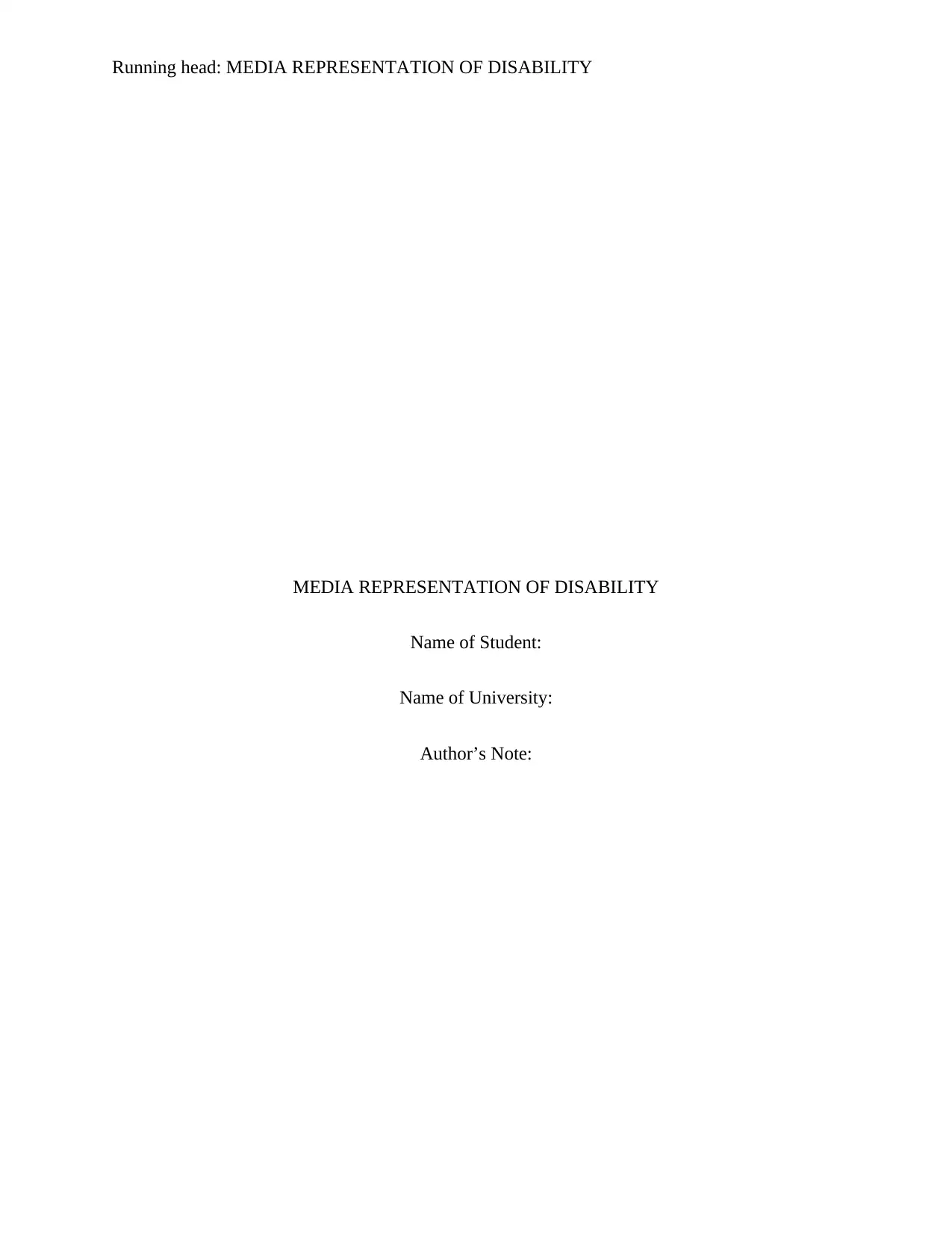
Running head: MEDIA REPRESENTATION OF DISABILITY
MEDIA REPRESENTATION OF DISABILITY
Name of Student:
Name of University:
Author’s Note:
MEDIA REPRESENTATION OF DISABILITY
Name of Student:
Name of University:
Author’s Note:
Paraphrase This Document
Need a fresh take? Get an instant paraphrase of this document with our AI Paraphraser
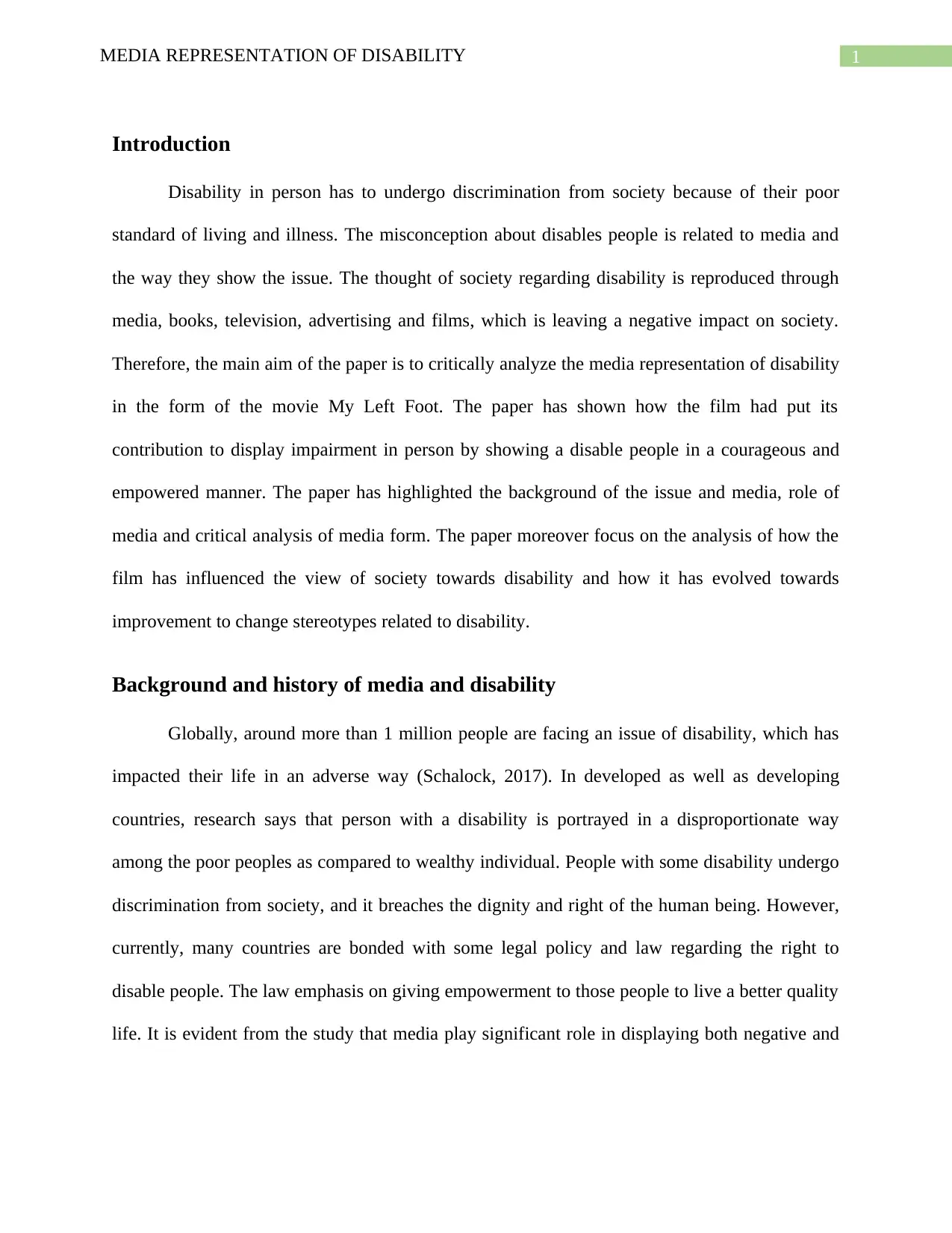
1MEDIA REPRESENTATION OF DISABILITY
Introduction
Disability in person has to undergo discrimination from society because of their poor
standard of living and illness. The misconception about disables people is related to media and
the way they show the issue. The thought of society regarding disability is reproduced through
media, books, television, advertising and films, which is leaving a negative impact on society.
Therefore, the main aim of the paper is to critically analyze the media representation of disability
in the form of the movie My Left Foot. The paper has shown how the film had put its
contribution to display impairment in person by showing a disable people in a courageous and
empowered manner. The paper has highlighted the background of the issue and media, role of
media and critical analysis of media form. The paper moreover focus on the analysis of how the
film has influenced the view of society towards disability and how it has evolved towards
improvement to change stereotypes related to disability.
Background and history of media and disability
Globally, around more than 1 million people are facing an issue of disability, which has
impacted their life in an adverse way (Schalock, 2017). In developed as well as developing
countries, research says that person with a disability is portrayed in a disproportionate way
among the poor peoples as compared to wealthy individual. People with some disability undergo
discrimination from society, and it breaches the dignity and right of the human being. However,
currently, many countries are bonded with some legal policy and law regarding the right to
disable people. The law emphasis on giving empowerment to those people to live a better quality
life. It is evident from the study that media play significant role in displaying both negative and
Introduction
Disability in person has to undergo discrimination from society because of their poor
standard of living and illness. The misconception about disables people is related to media and
the way they show the issue. The thought of society regarding disability is reproduced through
media, books, television, advertising and films, which is leaving a negative impact on society.
Therefore, the main aim of the paper is to critically analyze the media representation of disability
in the form of the movie My Left Foot. The paper has shown how the film had put its
contribution to display impairment in person by showing a disable people in a courageous and
empowered manner. The paper has highlighted the background of the issue and media, role of
media and critical analysis of media form. The paper moreover focus on the analysis of how the
film has influenced the view of society towards disability and how it has evolved towards
improvement to change stereotypes related to disability.
Background and history of media and disability
Globally, around more than 1 million people are facing an issue of disability, which has
impacted their life in an adverse way (Schalock, 2017). In developed as well as developing
countries, research says that person with a disability is portrayed in a disproportionate way
among the poor peoples as compared to wealthy individual. People with some disability undergo
discrimination from society, and it breaches the dignity and right of the human being. However,
currently, many countries are bonded with some legal policy and law regarding the right to
disable people. The law emphasis on giving empowerment to those people to live a better quality
life. It is evident from the study that media play significant role in displaying both negative and
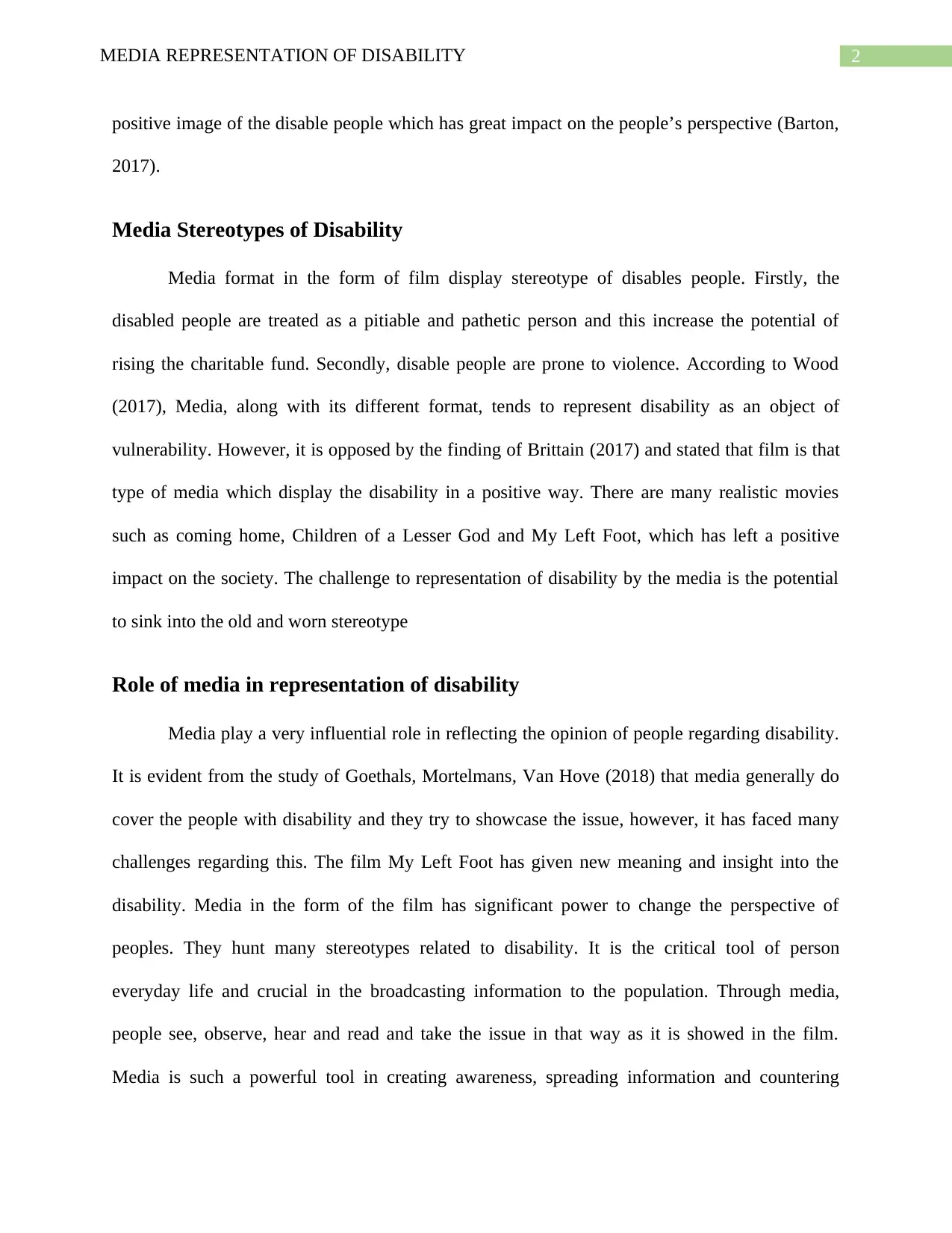
2MEDIA REPRESENTATION OF DISABILITY
positive image of the disable people which has great impact on the people’s perspective (Barton,
2017).
Media Stereotypes of Disability
Media format in the form of film display stereotype of disables people. Firstly, the
disabled people are treated as a pitiable and pathetic person and this increase the potential of
rising the charitable fund. Secondly, disable people are prone to violence. According to Wood
(2017), Media, along with its different format, tends to represent disability as an object of
vulnerability. However, it is opposed by the finding of Brittain (2017) and stated that film is that
type of media which display the disability in a positive way. There are many realistic movies
such as coming home, Children of a Lesser God and My Left Foot, which has left a positive
impact on the society. The challenge to representation of disability by the media is the potential
to sink into the old and worn stereotype
Role of media in representation of disability
Media play a very influential role in reflecting the opinion of people regarding disability.
It is evident from the study of Goethals, Mortelmans, Van Hove (2018) that media generally do
cover the people with disability and they try to showcase the issue, however, it has faced many
challenges regarding this. The film My Left Foot has given new meaning and insight into the
disability. Media in the form of the film has significant power to change the perspective of
peoples. They hunt many stereotypes related to disability. It is the critical tool of person
everyday life and crucial in the broadcasting information to the population. Through media,
people see, observe, hear and read and take the issue in that way as it is showed in the film.
Media is such a powerful tool in creating awareness, spreading information and countering
positive image of the disable people which has great impact on the people’s perspective (Barton,
2017).
Media Stereotypes of Disability
Media format in the form of film display stereotype of disables people. Firstly, the
disabled people are treated as a pitiable and pathetic person and this increase the potential of
rising the charitable fund. Secondly, disable people are prone to violence. According to Wood
(2017), Media, along with its different format, tends to represent disability as an object of
vulnerability. However, it is opposed by the finding of Brittain (2017) and stated that film is that
type of media which display the disability in a positive way. There are many realistic movies
such as coming home, Children of a Lesser God and My Left Foot, which has left a positive
impact on the society. The challenge to representation of disability by the media is the potential
to sink into the old and worn stereotype
Role of media in representation of disability
Media play a very influential role in reflecting the opinion of people regarding disability.
It is evident from the study of Goethals, Mortelmans, Van Hove (2018) that media generally do
cover the people with disability and they try to showcase the issue, however, it has faced many
challenges regarding this. The film My Left Foot has given new meaning and insight into the
disability. Media in the form of the film has significant power to change the perspective of
peoples. They hunt many stereotypes related to disability. It is the critical tool of person
everyday life and crucial in the broadcasting information to the population. Through media,
people see, observe, hear and read and take the issue in that way as it is showed in the film.
Media is such a powerful tool in creating awareness, spreading information and countering
⊘ This is a preview!⊘
Do you want full access?
Subscribe today to unlock all pages.

Trusted by 1+ million students worldwide
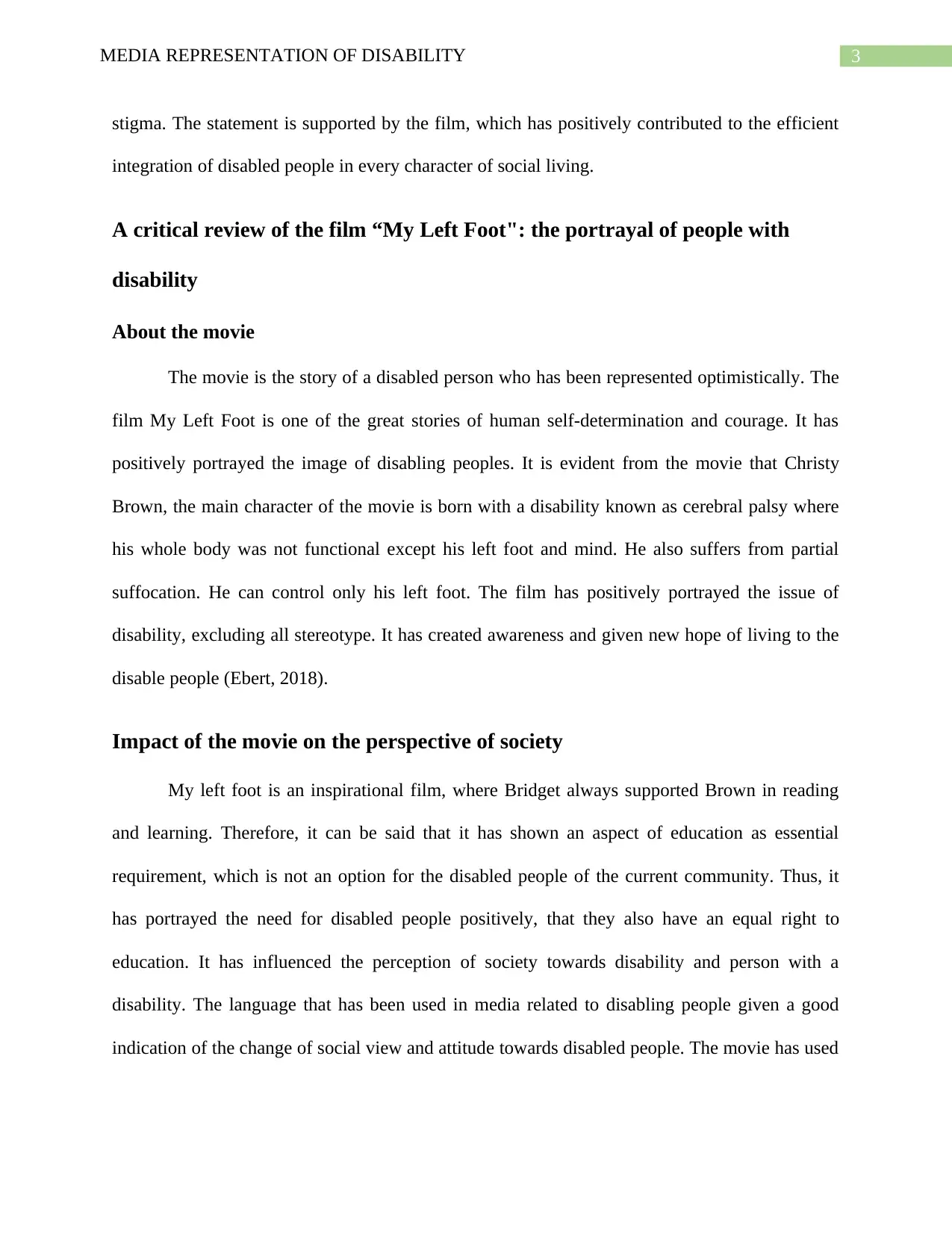
3MEDIA REPRESENTATION OF DISABILITY
stigma. The statement is supported by the film, which has positively contributed to the efficient
integration of disabled people in every character of social living.
A critical review of the film “My Left Foot": the portrayal of people with
disability
About the movie
The movie is the story of a disabled person who has been represented optimistically. The
film My Left Foot is one of the great stories of human self-determination and courage. It has
positively portrayed the image of disabling peoples. It is evident from the movie that Christy
Brown, the main character of the movie is born with a disability known as cerebral palsy where
his whole body was not functional except his left foot and mind. He also suffers from partial
suffocation. He can control only his left foot. The film has positively portrayed the issue of
disability, excluding all stereotype. It has created awareness and given new hope of living to the
disable people (Ebert, 2018).
Impact of the movie on the perspective of society
My left foot is an inspirational film, where Bridget always supported Brown in reading
and learning. Therefore, it can be said that it has shown an aspect of education as essential
requirement, which is not an option for the disabled people of the current community. Thus, it
has portrayed the need for disabled people positively, that they also have an equal right to
education. It has influenced the perception of society towards disability and person with a
disability. The language that has been used in media related to disabling people given a good
indication of the change of social view and attitude towards disabled people. The movie has used
stigma. The statement is supported by the film, which has positively contributed to the efficient
integration of disabled people in every character of social living.
A critical review of the film “My Left Foot": the portrayal of people with
disability
About the movie
The movie is the story of a disabled person who has been represented optimistically. The
film My Left Foot is one of the great stories of human self-determination and courage. It has
positively portrayed the image of disabling peoples. It is evident from the movie that Christy
Brown, the main character of the movie is born with a disability known as cerebral palsy where
his whole body was not functional except his left foot and mind. He also suffers from partial
suffocation. He can control only his left foot. The film has positively portrayed the issue of
disability, excluding all stereotype. It has created awareness and given new hope of living to the
disable people (Ebert, 2018).
Impact of the movie on the perspective of society
My left foot is an inspirational film, where Bridget always supported Brown in reading
and learning. Therefore, it can be said that it has shown an aspect of education as essential
requirement, which is not an option for the disabled people of the current community. Thus, it
has portrayed the need for disabled people positively, that they also have an equal right to
education. It has influenced the perception of society towards disability and person with a
disability. The language that has been used in media related to disabling people given a good
indication of the change of social view and attitude towards disabled people. The movie has used
Paraphrase This Document
Need a fresh take? Get an instant paraphrase of this document with our AI Paraphraser
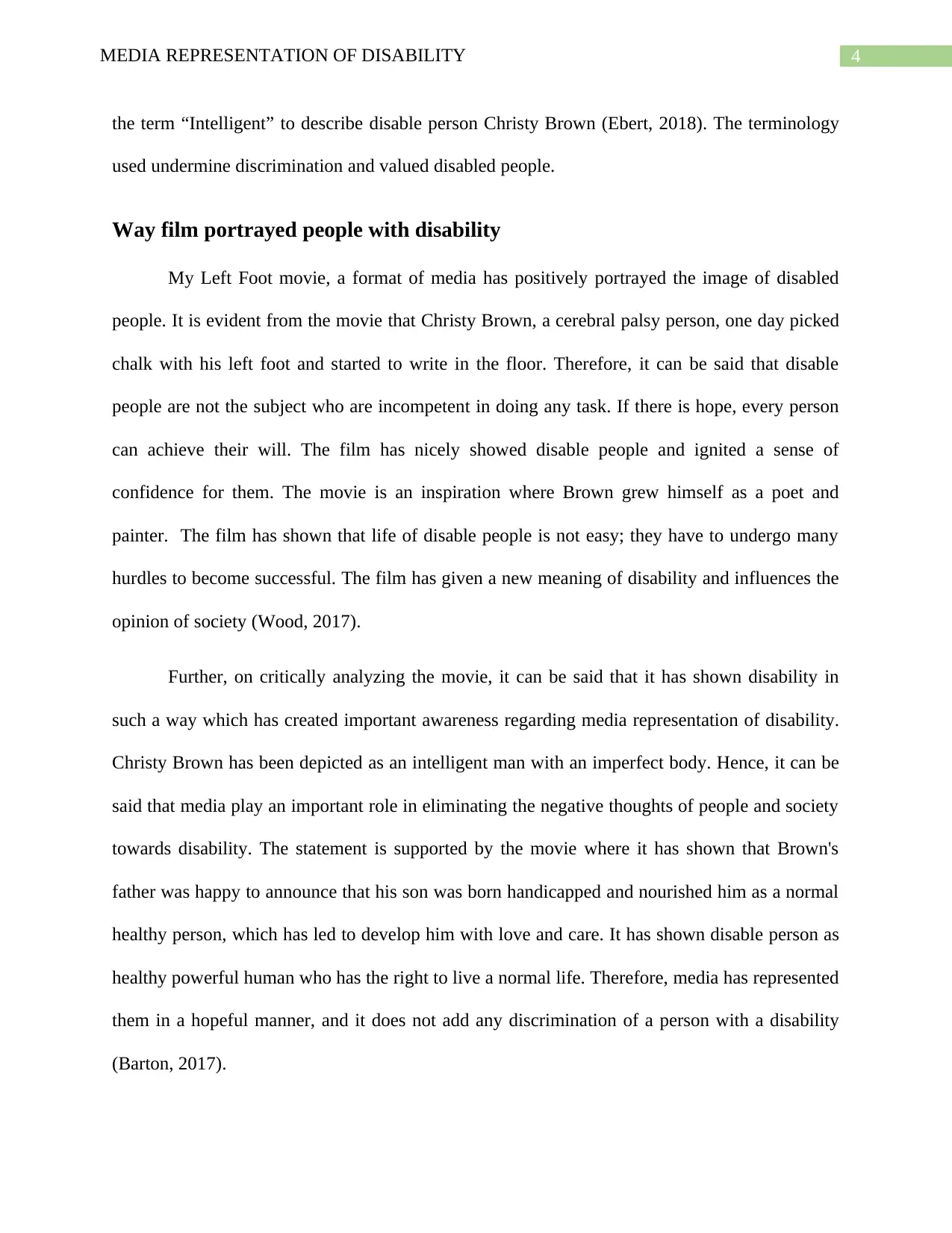
4MEDIA REPRESENTATION OF DISABILITY
the term “Intelligent” to describe disable person Christy Brown (Ebert, 2018). The terminology
used undermine discrimination and valued disabled people.
Way film portrayed people with disability
My Left Foot movie, a format of media has positively portrayed the image of disabled
people. It is evident from the movie that Christy Brown, a cerebral palsy person, one day picked
chalk with his left foot and started to write in the floor. Therefore, it can be said that disable
people are not the subject who are incompetent in doing any task. If there is hope, every person
can achieve their will. The film has nicely showed disable people and ignited a sense of
confidence for them. The movie is an inspiration where Brown grew himself as a poet and
painter. The film has shown that life of disable people is not easy; they have to undergo many
hurdles to become successful. The film has given a new meaning of disability and influences the
opinion of society (Wood, 2017).
Further, on critically analyzing the movie, it can be said that it has shown disability in
such a way which has created important awareness regarding media representation of disability.
Christy Brown has been depicted as an intelligent man with an imperfect body. Hence, it can be
said that media play an important role in eliminating the negative thoughts of people and society
towards disability. The statement is supported by the movie where it has shown that Brown's
father was happy to announce that his son was born handicapped and nourished him as a normal
healthy person, which has led to develop him with love and care. It has shown disable person as
healthy powerful human who has the right to live a normal life. Therefore, media has represented
them in a hopeful manner, and it does not add any discrimination of a person with a disability
(Barton, 2017).
the term “Intelligent” to describe disable person Christy Brown (Ebert, 2018). The terminology
used undermine discrimination and valued disabled people.
Way film portrayed people with disability
My Left Foot movie, a format of media has positively portrayed the image of disabled
people. It is evident from the movie that Christy Brown, a cerebral palsy person, one day picked
chalk with his left foot and started to write in the floor. Therefore, it can be said that disable
people are not the subject who are incompetent in doing any task. If there is hope, every person
can achieve their will. The film has nicely showed disable people and ignited a sense of
confidence for them. The movie is an inspiration where Brown grew himself as a poet and
painter. The film has shown that life of disable people is not easy; they have to undergo many
hurdles to become successful. The film has given a new meaning of disability and influences the
opinion of society (Wood, 2017).
Further, on critically analyzing the movie, it can be said that it has shown disability in
such a way which has created important awareness regarding media representation of disability.
Christy Brown has been depicted as an intelligent man with an imperfect body. Hence, it can be
said that media play an important role in eliminating the negative thoughts of people and society
towards disability. The statement is supported by the movie where it has shown that Brown's
father was happy to announce that his son was born handicapped and nourished him as a normal
healthy person, which has led to develop him with love and care. It has shown disable person as
healthy powerful human who has the right to live a normal life. Therefore, media has represented
them in a hopeful manner, and it does not add any discrimination of a person with a disability
(Barton, 2017).
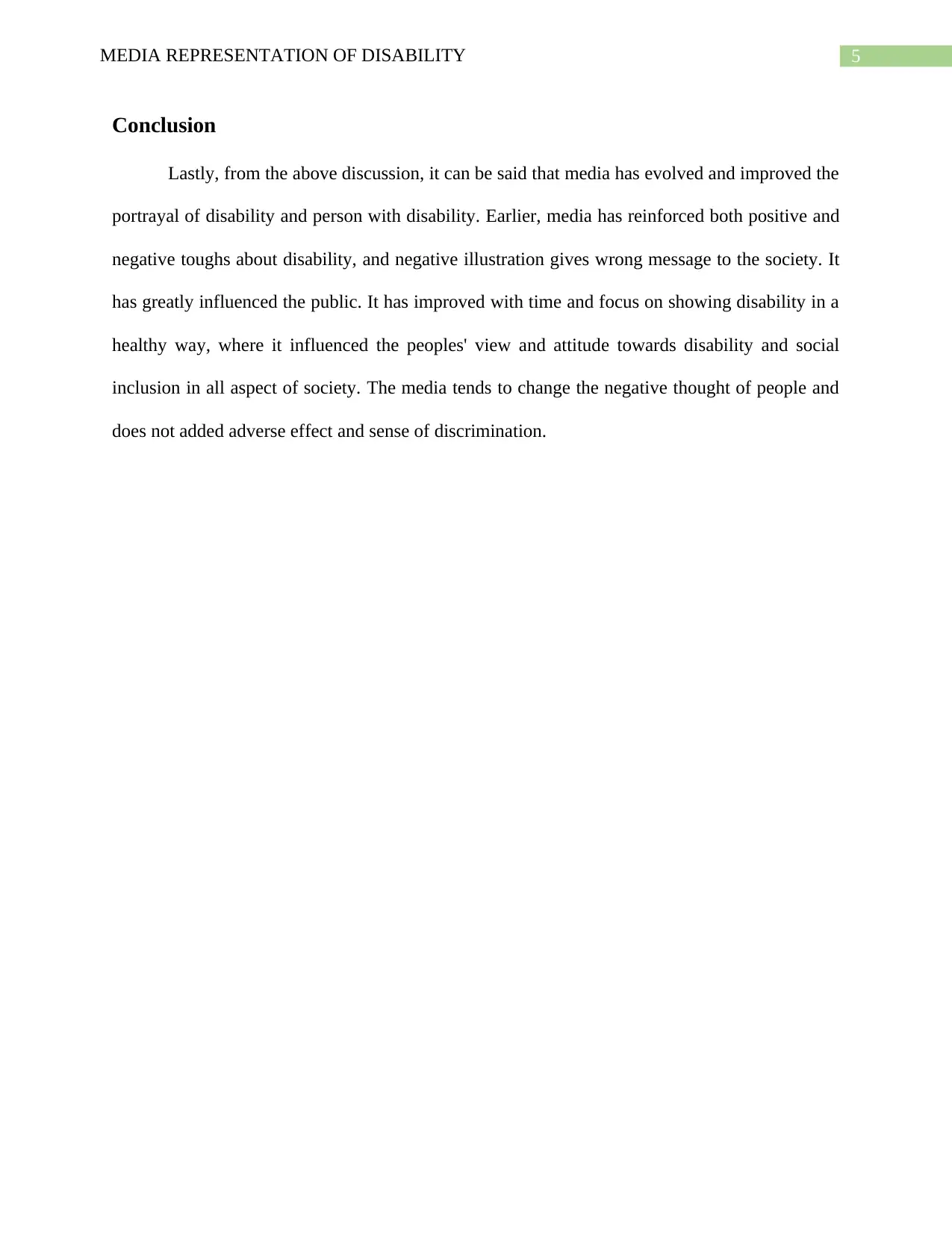
5MEDIA REPRESENTATION OF DISABILITY
Conclusion
Lastly, from the above discussion, it can be said that media has evolved and improved the
portrayal of disability and person with disability. Earlier, media has reinforced both positive and
negative toughs about disability, and negative illustration gives wrong message to the society. It
has greatly influenced the public. It has improved with time and focus on showing disability in a
healthy way, where it influenced the peoples' view and attitude towards disability and social
inclusion in all aspect of society. The media tends to change the negative thought of people and
does not added adverse effect and sense of discrimination.
Conclusion
Lastly, from the above discussion, it can be said that media has evolved and improved the
portrayal of disability and person with disability. Earlier, media has reinforced both positive and
negative toughs about disability, and negative illustration gives wrong message to the society. It
has greatly influenced the public. It has improved with time and focus on showing disability in a
healthy way, where it influenced the peoples' view and attitude towards disability and social
inclusion in all aspect of society. The media tends to change the negative thought of people and
does not added adverse effect and sense of discrimination.
⊘ This is a preview!⊘
Do you want full access?
Subscribe today to unlock all pages.

Trusted by 1+ million students worldwide
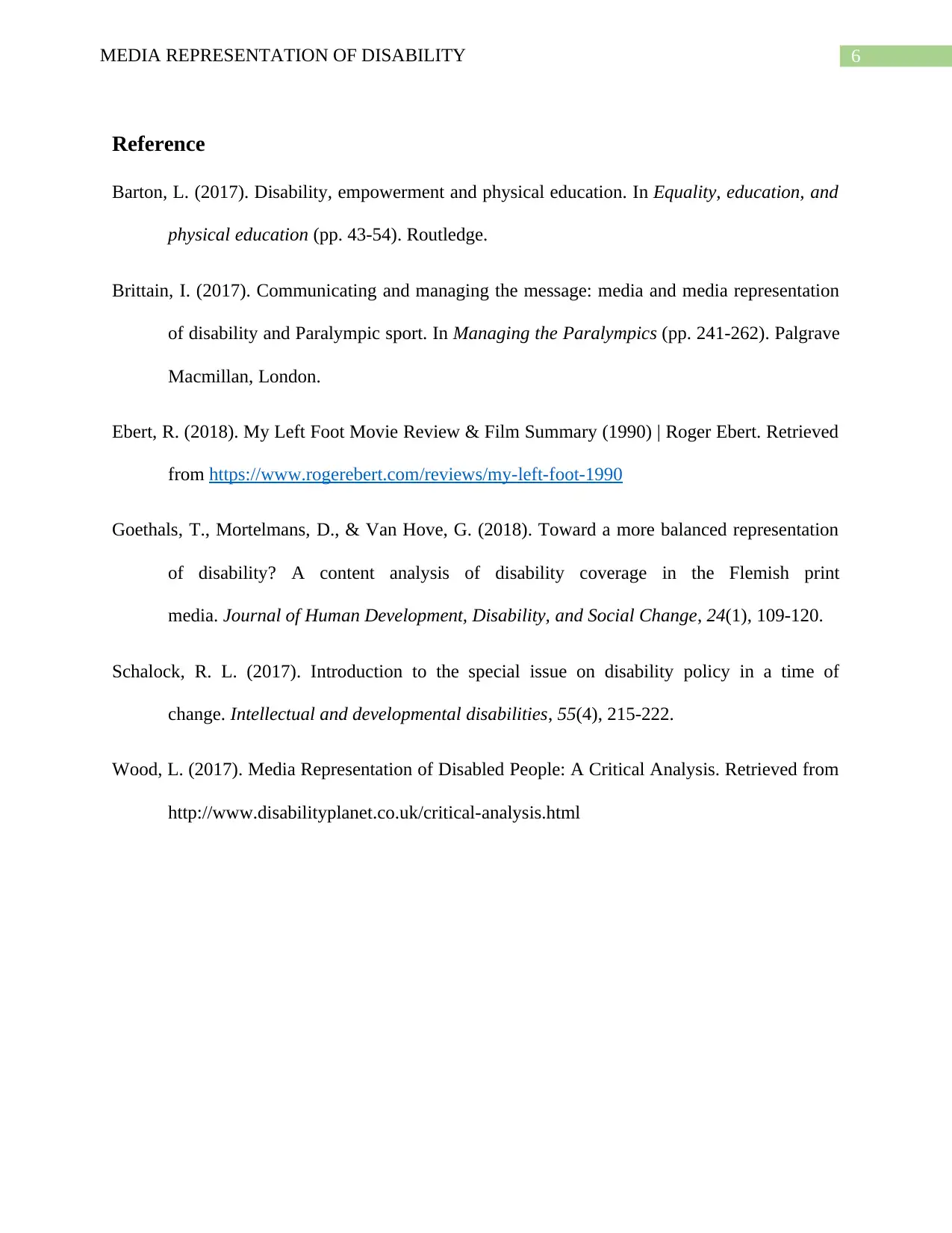
6MEDIA REPRESENTATION OF DISABILITY
Reference
Barton, L. (2017). Disability, empowerment and physical education. In Equality, education, and
physical education (pp. 43-54). Routledge.
Brittain, I. (2017). Communicating and managing the message: media and media representation
of disability and Paralympic sport. In Managing the Paralympics (pp. 241-262). Palgrave
Macmillan, London.
Ebert, R. (2018). My Left Foot Movie Review & Film Summary (1990) | Roger Ebert. Retrieved
from https://www.rogerebert.com/reviews/my-left-foot-1990
Goethals, T., Mortelmans, D., & Van Hove, G. (2018). Toward a more balanced representation
of disability? A content analysis of disability coverage in the Flemish print
media. Journal of Human Development, Disability, and Social Change, 24(1), 109-120.
Schalock, R. L. (2017). Introduction to the special issue on disability policy in a time of
change. Intellectual and developmental disabilities, 55(4), 215-222.
Wood, L. (2017). Media Representation of Disabled People: A Critical Analysis. Retrieved from
http://www.disabilityplanet.co.uk/critical-analysis.html
Reference
Barton, L. (2017). Disability, empowerment and physical education. In Equality, education, and
physical education (pp. 43-54). Routledge.
Brittain, I. (2017). Communicating and managing the message: media and media representation
of disability and Paralympic sport. In Managing the Paralympics (pp. 241-262). Palgrave
Macmillan, London.
Ebert, R. (2018). My Left Foot Movie Review & Film Summary (1990) | Roger Ebert. Retrieved
from https://www.rogerebert.com/reviews/my-left-foot-1990
Goethals, T., Mortelmans, D., & Van Hove, G. (2018). Toward a more balanced representation
of disability? A content analysis of disability coverage in the Flemish print
media. Journal of Human Development, Disability, and Social Change, 24(1), 109-120.
Schalock, R. L. (2017). Introduction to the special issue on disability policy in a time of
change. Intellectual and developmental disabilities, 55(4), 215-222.
Wood, L. (2017). Media Representation of Disabled People: A Critical Analysis. Retrieved from
http://www.disabilityplanet.co.uk/critical-analysis.html
1 out of 7
Related Documents
Your All-in-One AI-Powered Toolkit for Academic Success.
+13062052269
info@desklib.com
Available 24*7 on WhatsApp / Email
![[object Object]](/_next/static/media/star-bottom.7253800d.svg)
Unlock your academic potential
Copyright © 2020–2025 A2Z Services. All Rights Reserved. Developed and managed by ZUCOL.





